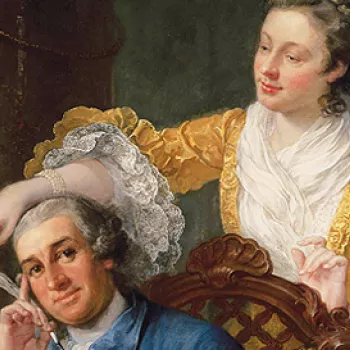Sir Henry Guildford (1489-1532) Dated 1527
Oil on oak panel | 82.7 x 66.4 cm (support, canvas/panel/stretcher external) | RCIN 400046
-
Hans Holbein the Younger was born in Augsburg where he was trained by his father, Hans Holbein the Elder. He became a member of the painter's guild at Basel in 1519. He visited France in 1524 and first visited London in 1526-8. He returned to England in 1532 and shortly afterwards was employed by Henry VIII for whom he painted numerous portraits of the King, the Royal Family and members of the court. Holbein remained in royal service until his death (probably caused by plague) in 1543.
This is one of Holbein’s most impressive surviving portraits. It shows the sitter standing three-quarter length, richly dressed in velvet, fur and cloth-of-gold. Holbein has meticulously shown the varied texture of his cloth-of-gold doublet which is woven into a pomegranate pattern with a variety of different weaves including loops of gold thread. Similarly, he has carefully articulated the band of black satin running down Guildford’s arm against the richer black of the velvet of his sleeve. A lavish use of both shell-gold paint and gold leaf (which has been used to emulate the highlights of the gold thread in the material) emphasises the luxuriousness of the sitter’s dress and his high status. Holbein re-uses a simplified version of the cloth-of-gold fabric for his later portrait of Edward VI as a child (National Gallery of Art, Washington), although he has not modified the scale of the pattern for the child's garment resulting in it looking over-large.
Guildford holds the white staff of office of the Comptroller of the Household, and a hat badge showing a clock and geometrical instruments. That this badge is not shown in the preparatory drawing may suggest that it was the subject of a separate study, or an afterthought on the part of the artist or sitter. Sir Henry stands against a deep blue background, decorated with the twisting vine found in a number of Holbein’s portraits. Above his head is a curtain rail, from which hangs a rich green curtain, perhaps a reference to the painted curtain that was so realistic it tricked the ancient Greek artist Zeuxis and proved the skill of the painter Parrhasius. This detail has lost context in the separation of the portrait from its companion, that of Guildford’s wife Mary (now in the St Louis Art Museum, MO), who is placed by a pillar with a continuation of the rail above her head. The rail and the pillar, the corner of which can be seen in the top right corner of Guildford’s portrait, united the two works, which must originally have been hung together. The cartellino on the painting, which records Guildford’s age as 49, is a later addition, and the sitter is in fact shown aged 38.
Sir Henry Guildford (1489‒1532) was one of Henry VIII’s closest friends. On the King’s accession in 1509 he was appointed Esquire of the Body - a personal attendant on the King - and Master of Revels, responsible for organising the lavish entertainments at court. His parties included morris dancers, moving stages and a series of elaborate costumes for the young King. Guildford’s influence at court was cut short in the 1519 purge of the so-called ‘minions’, an attempt by older statesmen to limit the influence of hot-headed young men on the 28-year-old monarch. Guildford soon returned to court, however, and developed a distinguished career as Comptroller of the Royal Household. In his continuing support for Katherine of Aragon he made a dangerous enemy of the King’s mistress, Anne Boleyn, and it is a mark of his friendship with Henry that he remained in post until his death in 1532.
Guildford was a keen scholar as well as an experienced courtier, and his humanist interests may have drawn him to Hans Holbein, who arrived in England with a recommendation from Desiderius Erasmus. The two almost certainly worked together in the planning of revels at Greenwich in 1527, when a ‘Master Hans’ carried out much of the decorative painting. Guildford was one of the first in England to commission a portrait from Holbein; both the preparatory drawing and the finished oil painting survive.
Inscribed at a later date: Anno. D: MCCCCCXXVII. / Etatis. Suae. .xl ix: (Year 1527 / His Age 49)
Catalogue entry adapted from The Northern Renaissance. Dürer to Holbein, London 2011Provenance
Thomas Howard, Earl of Arundel; purchased from his heirs by George II or Queen Caroline; recorded in the Privy Chamber at Kensington Palace in 1732
-
Creator(s)
Acquirer(s)
-
Medium and techniques
Oil on oak panel
Measurements
82.7 x 66.4 cm (support, canvas/panel/stretcher external)










